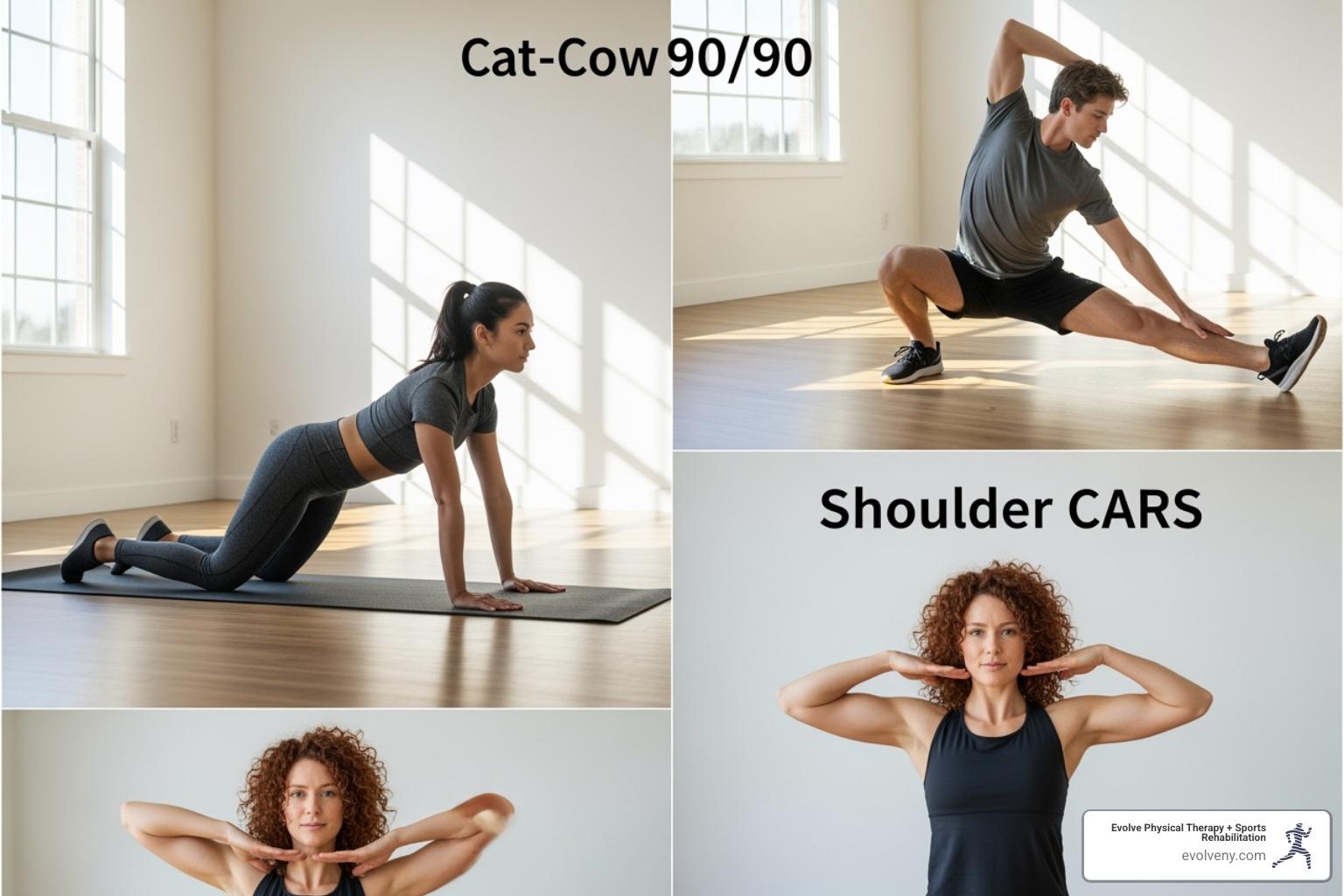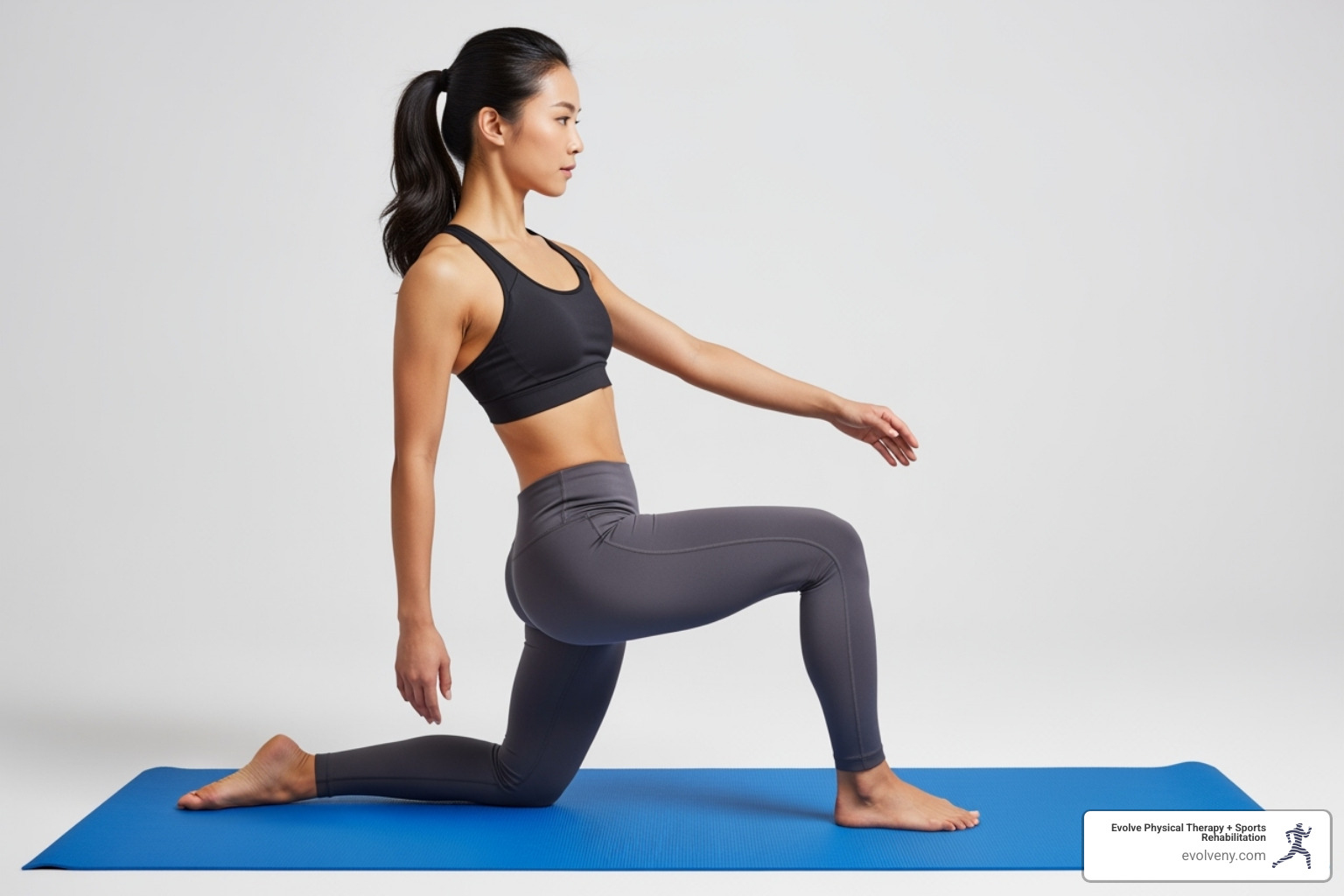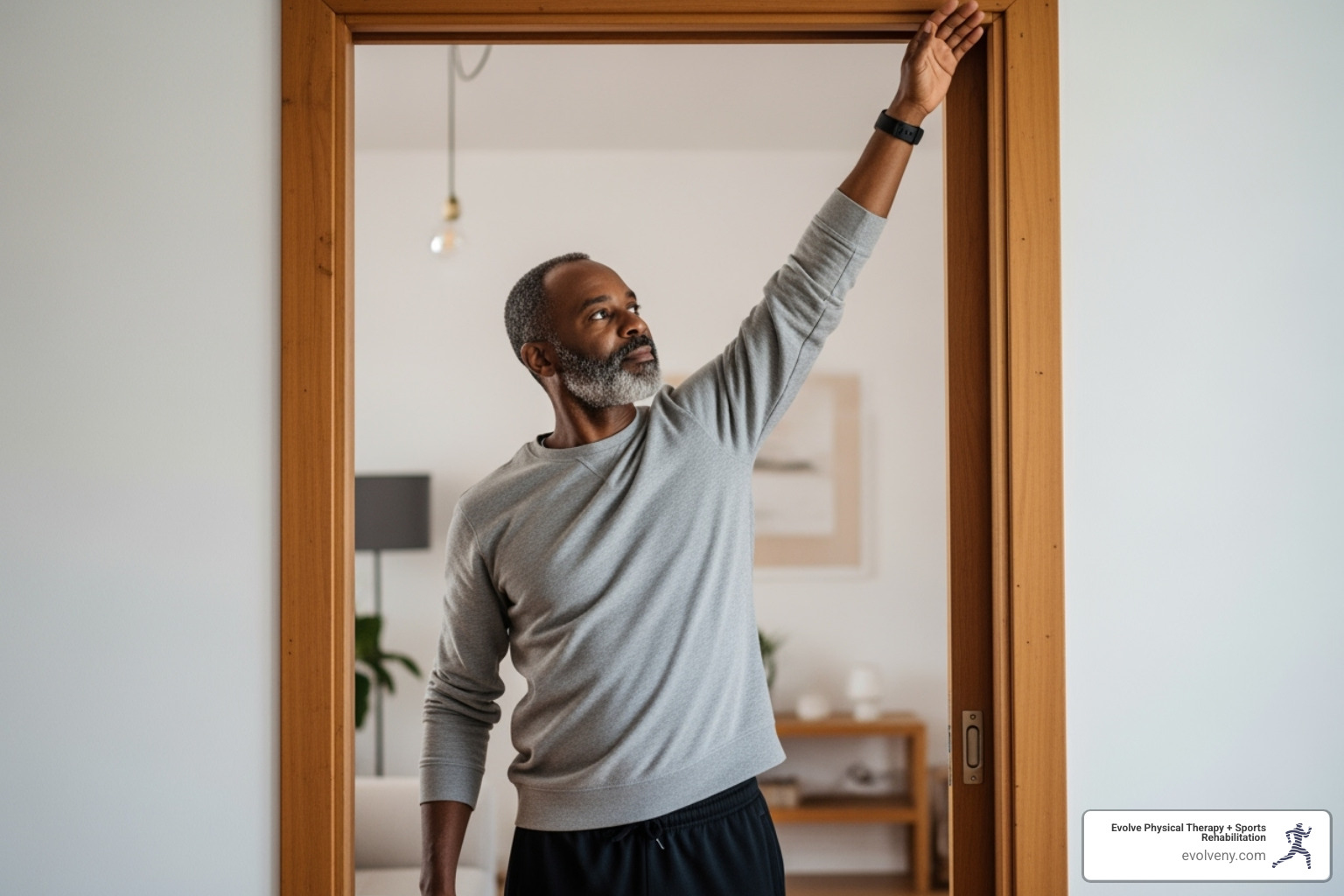Mobility Magic: Exercises to Boost Your Range of Motion
The Best Mobility Movements for Key Body Areas

Ready to put mobility theory into action? The best mobility movements are those that take your joints through their full range of motion with control and purpose. These aren't just stretches—they're dynamic movements that prepare your body for action and improve how you move every day.
Think of mobility work as giving your joints a daily tune-up. Just like your car runs better with regular maintenance, your body performs better when you regularly move your joints through their full range of motion. We use these exact movements in our Therapeutic Exercise Programs to help our patients heal faster and move better.
The movements we're about to share target the three areas that matter most for daily function: your hips, lower back, and shoulders. These are the spots where stiffness tends to creep in first, and they're also the areas that give you the biggest bang for your buck when it comes to feeling better.
Best mobility movements for hip health
Your hips are the unsung heroes of your lower body. When they're happy and mobile, everything else tends to fall into place. When they're tight? Well, that's when your lower back starts complaining, your knees feel cranky, and even your posture suffers.
The good news is that hip mobility responds beautifully to consistent work. Whether you're dealing with tight hip flexors from sitting all day or need better rotation for your golf swing, these movements will help you move with more ease and confidence.

90/90 Hip Switches are fantastic for improving both internal and external hip rotation—movements that often get neglected in our daily lives. Sit on the floor with both knees bent at 90 degrees, one leg internally rotated in front of you and the other externally rotated to the side. Slowly switch the position of your legs, moving from your hips rather than forcing it with your knees. Start with 5-10 switches per side, focusing on smooth, controlled movement.
The Spider Lunge with Thoracic Rotation, often called the World's Greatest Stretch, lives up to its name by targeting your hip flexors, hamstrings, and upper back all at once. From a push-up position, step your right foot outside your right hand into a deep lunge. Keep your left hand planted and rotate your right arm up toward the ceiling, twisting your torso. This movement feels incredible after a long day of sitting.
Cat-Cow might seem like it's just for your spine, but it also gently mobilizes your pelvis and helps your entire core move more freely. Start on all fours and flow between arching your back (Cow) and rounding it toward the ceiling (Cat). The key is coordinating the movement with your breath—inhale as you arch, exhale as you round.
Standing Hip CARs (Controlled Articular Rotations) actively take your hip through its complete range of motion while building strength and control. Standing tall with one hand on a wall for balance, lift one knee to 90 degrees and slowly trace the largest possible circle with your knee—forward, out to the side, back, and around again. Keep your torso still and move only from the hip.
Cossack Squats are excellent for targeting those often-tight inner thigh muscles (adductors) while improving single-leg stability. Stand with your feet wide apart, then shift your weight to one side, squatting down on that leg while keeping the other leg straight. It's like a deep lateral squat that really opens up your hips.
For even more hip-focused movements, check out our guide on 5 Hip Movements to Help Strengthen and Prevent Pain.
Best mobility movements for a resilient lower back
Your lower back bears the brunt of modern life—hours of sitting, poor posture, and general stress all take their toll. But here's the thing: a resilient lower back isn't just about having strong muscles. It's about having a spine that can move freely and a core that provides the right amount of stability at the right times.
These movements focus on gently mobilizing your spine while teaching your body how to move with more control and awareness. They're particularly helpful if you spend a lot of time at a desk or if you wake up feeling stiff and creaky.
Segmented Cat-Cow takes the classic movement and adds a layer of spinal awareness that's incredibly beneficial. Instead of moving your whole spine at once, start from your tailbone and slowly articulate one vertebra at a time, like a wave moving up your spine. This teaches your brain to control individual spinal segments, which is crucial for healthy movement patterns.
Side-Lying Thoracic Rotations (also called Open Books) target your mid-back while keeping your lower back stable. Lie on your side with your knees bent and stacked, arms extended in front of you. Keep your bottom arm on the floor and slowly open your top arm like a book, rotating your torso while keeping your knees glued together. This movement feels amazing and helps counteract the forward-rounded posture many of us develop.
Supine Windshield Wipers provide gentle rotational movement for your lumbar spine and hips. Lying on your back with knees bent, slowly let both knees fall to one side while keeping your shoulders on the floor, then bring them back to center and over to the other side. It's simple, relaxing, and incredibly effective for reducing lower back tension.
If you're dealing with desk-related back issues, our guides on Ideal Desk Posture and Physical Therapy for Core Strengthening can provide additional strategies for keeping your back healthy.
Best mobility movements for shoulder function
Your shoulders are incredibly complex joints designed for an amazing range of motion. Unfortunately, modern life—with all its typing, texting, and hunching over devices—tends to lock them into limited positions. This can lead to stiffness, pain, and that rounded-forward posture that makes you look older than you feel.
The key to healthy shoulders isn't just stretching the front of your chest (though that helps). It's about improving the mobility of your entire shoulder complex, including your mid-back, which plays a huge role in shoulder function.

Shoulder CARs are among the best mobility movements for actively building shoulder strength and control throughout the entire range of motion. Standing tall, make a fist with your thumb inside and slowly trace the largest possible circle with your straight arm—forward, up, out to the side, and back behind you. The key is maintaining control without letting your torso compensate. It's harder than it sounds, but incredibly effective.
Dead Hangs might sound intimidating, but they're fantastic for decompressing your spine and improving your grip strength and overhead shoulder range. Simply hang from a pull-up bar with an overhand grip, letting your body relax completely. Even 30 seconds can make a difference, and you can work up to longer holds over time.
Wall Slides (or Wall Angels) promote proper shoulder blade movement while strengthening your upper back muscles. Standing with your back against a wall, press your forearms flat against the wall and slowly slide them up and down like you're making a snow angel. This movement helps counteract the forward-rounded posture that's so common today.
Thoracic Extension over a Foam Roller targets the stiffness in your mid-back that often limits your ability to move your arms overhead. Lie on your back with a foam roller positioned under your shoulder blades, hands supporting your head, and gently extend your spine over the roller. This movement can be a game-changer for improving overhead shoulder mobility.
Understanding how your mid-back affects your shoulders is crucial, which is why we've written extensively about Thoracic Mobility: Why Is It Important?. You can also learn more about the benefits of foam rolling in our guide What Does Foam Rolling Do for Me?.
How to Integrate Mobility Training Into Your Life
We understand that adding something new to an already busy schedule can feel overwhelming. But the good news is, integrating best mobility movements doesn't have to mean hours in the gym. Consistency is truly key here; short, frequent sessions are often more effective than sporadic, lengthy ones. Think of it as a "movement snack" you can incorporate throughout your day, perhaps as part of your warm-ups, cool-downs, or even active recovery. For more ideas on how to weave movement into your routine, check out our tips on Daily Stretches to Keep You Limber.
How Often Should You Do Mobility Work?
The ideal frequency and duration for mobility work depend on your individual fitness levels and goals, but we recommend doing it consistently. It's far more beneficial to practice mobility five times a week for 5 to 10 minutes each time, rather than trying to squeeze in a single, hour-long session once a week.
You can easily add mobility training as part of your warm-up or activation routine before a workout. Or, you can integrate functional unilateral movements that challenge stability and strength in multiple planes right into your existing workouts. It can also be a fantastic way to start your day, end your day, or serve as active recovery on non-training days.
As we always tell our patients, "the best kind of exercise is the one that you can find time for." Even five minutes a few times a week will have a positive benefit. So, start slow, listen to your body, and gradually build it into a habit. Our goal for you is to move comfortably through life, and consistent mobility work is a cornerstone of that.
Equipment and Tracking Your Progress
The cool thing about mobility training is that you can usually do it anywhere, with minimal or no equipment. Most of the best mobility movements we've discussed only require your bodyweight and perhaps a yoga mat for comfort. However, some simple tools can be quite helpful. A foam roller is excellent for self-massage and targeting tight areas like your lats or thoracic spine. Resistance bands can be used to add resistance to movements or provide assistance for stretches. And for those stubborn, pinpointed trigger points in smaller muscles like those in your hips or feet, a small mobility ball (like a lacrosse ball) can work wonders.
Tracking Your Progress: How do you know if you're actually improving? Mobility progress can be subtle, but there are several fantastic ways to track it.
One of the best ways to get objective feedback is to film yourself. Try performing key movements (like a deep squat or an overhead reach) before you start a dedicated mobility routine and then again after a few weeks. You'll often be surprised by the visual improvements.
Another simple yet powerful method is to keep a workout journal. Note how your body feels during and after exercises. Are you able to go a little deeper into a stretch? Does a certain movement feel less restricted? Are your daily aches diminishing?
Always remember to focus on quality over quantity. When performing mobility exercises, prioritize proper form and control over the sheer range of motion. It's not about how far you can push, but how well you can control the movement throughout its full range. We always say, Prioritize control and form—it's the foundation of effective exercise.
Finally, a simple but effective strategy is to test and re-test. Before focusing on a specific area, perform a simple mobility test (like a deep squat assessment or an overhead reach test). Work on that area consistently for a few weeks, then re-test to see the improvements you've made.
Frequently Asked Questions about Mobility Movements
Here at Evolve, we hear these questions a lot! It's great to see so many people curious about how mobility can transform their lives. Let's explore some of the most common questions we get.
Who can benefit most from mobility training?
Who exactly can benefit from focusing on best mobility movements? Honestly, it's pretty much everyone! Whether you're a hardcore athlete or someone who spends most of their day at a desk, mobility training brings a world of good.
Think about it: If you're a desk worker, prolonged sitting can make your hips tight, your lower back stiff, and your shoulders rounded. Mobility work is like a secret weapon to undo all that, helping you sit taller and feel more comfortable.
For athletes, no matter your sport, better mobility means better performance. It helps you move more efficiently, reach optimal positions, and seriously lowers your risk of injury.
And for our seniors, keeping good mobility is absolutely vital for staying independent and enjoying daily life. It helps prevent falls and keeps you moving comfortably for years to come. In fact, we even have specialized Balance Training for Seniors programs to help with this!
If you're an individual with stiffness or chronic aches – those morning creaks, "cranky hips," or nagging lower back pain – mobility exercises can offer huge relief by getting your joints moving better and balancing your muscles.
Finally, for people recovering from injury, mobility work is a crucial piece of the puzzle. Always with professional guidance, of course, it helps restore your full range of motion and keeps those injuries from coming back.
Can mobility training help with pain?
This is a big one, and the answer is a resounding yes! Mobility training can be incredibly powerful in easing, and sometimes even getting rid of, many common types of chronic pain. It's truly a game-changer for how your body feels.
Here’s how those best mobility movements work their magic against pain: First, they reduce stiffness. By gently moving your joints through their full range, you're helping them get more "lubricated," which just makes everything feel less creaky and tight.
Next, mobility improves joint function. When your joints move the way they're supposed to, they share the load better. This means less stress on those specific spots that might be causing you grief.
It also corrects tricky movement patterns. Sometimes, pain shows up because your body is trying to compensate for stiffness elsewhere. Mobility training gets to the root of the problem, helping your body refind its natural, efficient ways of moving.
And finally, it alleviates muscle tightness. While mobility is different from pure flexibility, many mobility drills actively help lengthen muscles and release that built-up tension that often causes discomfort.
Now, a quick but important note: if you're dealing with sharp or ongoing pain, please don't try to tough it out alone. It’s always best to chat with a professional. Physical therapists, like us here at Evolve, are experts at figuring out why you’re hurting and creating a plan just for you.
Should I do mobility before or after a workout?
This is where understanding the type of mobility work really helps. The short answer is: both, but with different goals in mind.
Before a workout, think dynamic mobility. These are those active, controlled movements that get your blood flowing, gently wake up your joints, and tell your nervous system it's time to move! Think leg swings, arm circles, or a gentle Cat-Cow. These are perfect to get your body ready for action and maximize your performance in the main workout.
After a workout, it's time for more static or passive mobility. This is when those longer, held stretches come into play. Holding a stretch for 20-30 seconds helps your muscles gently lengthen, improves overall flexibility, and aids in your body's recovery. It's like giving your muscles a nice, gentle thank-you for all their hard work.
And here’s a bonus: mobility work can also be a fantastic standalone session. On recovery days, or simply any time you feel a bit stiff, a dedicated mobility session can do wonders. Short, frequent "movement snacks" throughout your day can often be more effective than one long, infrequent session. Consistency really is key!
Conclusion: Move Better, Feel Better
We truly hope this guide to the best mobility movements has opened your eyes to a world of possibility! It’s all about empowering you to take charge of your physical well-being. Think of it as investing in your future – a future with less pain, better performance in everything you do, and the ability to move freely for years to come.
Remember what we covered: mobility isn't just flexibility. It’s about having active, controlled movement through your joints. This makes a massive difference in preventing injuries, boosting your athletic prowess, and simply making daily life feel easier.
The magic word? Consistency. You don't need huge, marathon sessions. Even short, regular "movement snacks" can add up to incredible benefits. Start small, listen to what your body tells you, and celebrate every little win along the way. That feeling of reaching a little further, or moving with less stiffness, is a victory!
However, we understand that sometimes, pain can be persistent, or movement limitations feel overwhelming. If you're struggling with ongoing discomfort or feel stuck, please don't hesitate to reach out. Our dedicated team at Evolve Physical Therapy + Sports Rehabilitation in Brooklyn is here to help. We offer holistic physical therapy services, focusing on a hands-on approach to evaluate, heal, and strengthen your body. We can provide a personalized plan designed just for you, helping you truly move better and feel better. Why not get a professional movement analysis with physical therapy today? Your body will thank you!
